| Правильный додекаэдр | |||
|---|---|---|---|
 (вращающаяся модель, 3D-модель) |
|||
| Тип | правильный многогранник | ||
| Свойства | выпуклый | ||
| Комбинаторика | |||
| Элементы |
|
||
| Грани | правильные пятиугольники | ||
| Конфигурация вершины | 53 | ||
| Двойственный многогранник | правильный икосаэдр | ||
|
Вершинная фигура
|
|||
|
Развёртка
|
|||
| Классификация | |||
| Обозначения | U23, C26, W5 | ||
| Символ Шлефли | {5,3} | ||
| Символ Витхоффа[en] | 3 | 2 5 | ||
| Диаграмма Дынкина |
|
||
| Группа симметрии | Ih, H3, [5,3], (*532) | ||
| Группа вращения | I, [5,3]+, (532) | ||
| Количественные данные | |||
| Длина ребра |
 |
||
| Площадь поверхности |
 |
||
| Объём |
 |
||
| Двугранный угол |
 |
||
| Телесный угол при вершине |
 |
||
Пра́вильный додека́эдр (др.-греч. δωδεκάεδρον, от δώδεκα — «двенадцать» и ἕδρα — «грань») — один из пяти возможных правильных многогранников. Додекаэдр составлен из двенадцати правильных пятиугольников[1], являющихся его гранями. Каждая вершина додекаэдра является вершиной трёх правильных пятиугольников. Таким образом, додекаэдр имеет 12 граней (пятиугольных), 30 рёбер и 20 вершин (в каждой сходятся 3 ребра).

Додекаэдр и его описанная сфера
История[править | править код]
Пожалуй, самый древний предмет в форме додекаэдра был найден в северной Италии, около Падуи, в конце XIX века, он датируется 500 г. до н. э. и предположительно использовался этрусками в качестве игральной кости[2][3].
Додекаэдр рассматривали в своих сочинениях древнегреческие учёные. Платон сопоставлял с правильными многогранниками различные классические стихии. О додекаэдре Платон писал, что «…его бог определил для Вселенной и прибегнул к нему в качестве образца»[4]. Евклид в предложении 17 книги XIII «Начал» строит додекаэдр на рёбрах куба[5][6]:132-136. Папп Александрийский в «Математическом собрании» занимается построением додекаэдра, вписанного в данную сферу, попутно доказывая, что вершины додекаэдра лежат в параллельных плоскостях[7][6]:318-319[8].
На территории нескольких европейских стран найдено множество предметов, называемых римскими додекаэдрами, относящихся ко II—III вв. н. э., назначение которых не совсем понятно.
Вскоре после появления кубика Рубика, в 1981 году была запатентована подобная головоломка в форме правильного додекаэдра — мегаминкс. Как и у классического кубика Рубика, к каждому ребру у неё прилегает по три детали[9]. Позднее, как и для кубика Рубика появились такие додекаэдрические головоломки с четырьмя деталями при ребре (гигаминкс), пятью (тераминкс) и т.д. Сложность и время сборки их, как и для кубика Рубика возрастает по мере увеличения числа деталей при ребре.
Основные формулы[править | править код]
Если за длину ребра принять 
Объём додекаэдра
Радиус описанной сферы[10]
Радиус полувписанной сферы равен 
Радиус вписанной сферы[10]
Свойства[править | править код]
- Все двадцать вершин додекаэдра лежат по пять в четырёх параллельных плоскостях, образуя в каждой из них правильный пятиугольник.
- Двугранный угол между любыми двумя смежными гранями додекаэдра равен arccos(−1/√5) ≈ 116,565°[10].
- Сумма плоских углов при каждой из 20 вершин равна 324°, телесный (трёхгранный) угол равен arccos(−11/5√5) ≈ 2,9617 стерадиана.
- В додекаэдр можно вписать куб так, что стороны куба будут диагоналями додекаэдра.
- Додекаэдр имеет три звёздчатые формы.
- В додекаэдр можно вписать пять кубов. Если заменить пятиугольные грани додекаэдра плоскими пятиугольными звездами так, что исчезнут все рёбра додекаэдра, то получим пространство пяти пересекающихся кубов. Додекаэдр как таковой исчезнет. Вместо замкнутого многогранника появится открытая геометрическая система пяти ортогональностей. Или симметричное пересечение пяти трёхмерных пространств.
- Ближайшая параллельная к произвольно выбранной грани плоскость, в которой лежат пять вершин, не принадлежащих выбранной грани, отстоит от этой грани на расстояние радиуса описанной вокруг данной грани окружности. А радиус описанной вокруг этих пяти вершин окружности равен диаметру вписанной в любую из граней окружности. Эти две величины равны, соответственно,
и
, где
— длина ребра додекаэдра.
Элементы симметрии додекаэдра[править | править код]
Связь со сферическим замощением[править | править код]
Правильный додэкаэдр также индуцирует замощение сферы правильными пятиугольниками.

|

|
| Ортографическая проекция[en] | Стереографическая проекция |
|---|
Интересные факты[править | править код]
- В 1887 году Эрнст Геккель описал радиолярию Circorrhegma dodecahedra, имеющую форму, близкую к додекаэдру[11].
- в 1982 году был синтезирован додекаэдран, химическое соединение (C20H20) в форме додекаэдра.
- В 2003 году при анализе данных космического аппарата WMAP, была выдвинута гипотеза, что Вселенная представляет собой додекаэдрическое пространство Пуанкаре[12][13][14].
В культуре[править | править код]
- Додекаэдр применяется как генератор случайных чисел (вместе с другими костями) в настольных ролевых играх[15], и обозначается при этом d12 (dice — кости).
- Изготавливаются настольные календари в форме додекаэдра из бумаги, где каждый из двенадцати месяцев расположен на одной из граней[15].
- В игре Пентакор мир представлен в виде этой геометрической фигуры[источник не указан 2658 дней].
- В играх «Sonic the Hedgehog 3» и «Sonic & Knuckles» серии Sonic the Hedgehog вид додекаэдра имеют Изумруды Хаоса[источник не указан 2658 дней].
- В игре «Destiny» форму додекаэдра имеют энграммы[источник не указан 2658 дней].
- В игре «Overwatch» персонаж Сигма при основной атаке выпускает по 2 додекаэдра[источник не указан 1135 дней].
- Пульт управления системой освещения Nanoleaf Smart Remote Control [16].
См. также[править | править код]
- Пентагондодекаэдр — неправильный додекаэдр
- Ромбододекаэдр
- Ромбоикосододекаэдр
- Двенадцатигранники
Примечания[править | править код]
- ↑ Селиванов Д. Ф.,. Тело геометрическое // Энциклопедический словарь Брокгауза и Ефрона : в 86 т. (82 т. и 4 доп.). — СПб., 1890—1907.
- ↑ Stefano De’ Stefani. Intorno un dodecaedro quasi regolare di pietra a facce pentagonali scolpite con cifre, scoperto nelle antichissime capanne di pietra del Monte Loffa (итал.) // Atti del Reale Istituto veneto di scienze, lettere ed arti : diario. — 1885-86. — P. 1437—1459. См. также изображение этого предмета в конце тома, стр. 709 файла со сканом
- ↑ Amelia Carolina Sparavigna. An Etruscan Dodecahedron. — arXiv:1205.0706.
- ↑ Платон. «Тимей»
- ↑ Euclid’s Elements. Book XIII. Proposition 17. Дата обращения: 1 июня 2014. Архивировано 19 мая 2014 года.
- ↑ 1 2 Начала Евклида. Книги XI—XV. — М.—Л.: Государственное издательство технико-теоретической литературы, 1950. — Помимо перевода на русский язык сочинения Евклида это издание в комментариях содержит перевод предложений Паппа о правильных многогранниках.
- ↑ Оригинальный текст на древнегреческом языке с параллельным переводом на латинский язык: Liber III. Propos. 58 // Pappi Alexandrini Collectionis. — 1876. — Т. I. — С. 156—163.
- ↑ Roger Herz-Fischler. A Mathematical History of the Golden Number (англ.). — Courier Dover Publications, 2013. — P. 117—118.
- ↑ Хорт В. Отчаянные головоломки. Мегаминкс — каверзный додекаэдр // Наука и жизнь. — 2018. — № 1. — С. 104—109. В этой статье, помимо прочего, приведён алгоритм сборки мегаминкса.
- ↑ 1 2 3 4 Доказательство приведено в: Cobb, John W. The Dodecahedron (англ.) (2005—2007). Дата обращения: 1 июня 2014. Архивировано 4 марта 2016 года.
- ↑ http://www.biodiversitylibrary.org/page/10685137#page/111/mode/1up таблице XVII] Архивная копия от 7 июня 2014 на Wayback Machine четвёртого тома его монографии о радиоляриях она обозначена номером 2
- ↑ The optimal phase of the generalised Poincare dodecahedral space hypothesis implied by the spatial cross-correlation function of the WMAP sky maps (англ.). Дата обращения: 31 октября 2012. Архивировано 7 декабря 2013 года.
- ↑ Dodecahedral space topology as an explanation for weak wide-angle temperature correlations in the cosmic microwave background (англ.). Дата обращения: 31 октября 2012. Архивировано 7 декабря 2013 года.
- ↑ Jeffrey Weeks. The Poincare Dodecahedral Space and the Mystery of the Missing Fluctuations (англ.). Архивировано 4 ноября 2012 года.
- ↑ 1 2 A. T. White. Graphs of Groups on Surfaces: Interactions and Models. — Elsevier, 2001. — P. 45. — 378 p. — ISBN 0-080-50758-1, 978-0-080-50758-3.
- ↑ Products » Nanoleaf Remote | USA » Consumer IoT & LED Smart Lighting Products (амер. англ.). Nanoleaf | USA. Дата обращения: 25 ноября 2021. Архивировано 25 ноября 2021 года.
Ссылки[править | править код]
 На Викискладе есть медиафайлы по теме Правильный додекаэдр
На Викискладе есть медиафайлы по теме Правильный додекаэдр
-
Вы здесь:
- Главная
- Додекаэдр
Додекаэдр

Древние греки дали многограннику имя по числу граней. «Додека» означает двенадцать, «хедра» – означает грань (додекаэдр – двенадцатигранник).
Поэтому на вопрос – “что такое додекаэдр?”, можно дать следующее определение: “Додекаэдр это геометрическое тело из двенадцати граней, каждая их которых – правильный пятиугольник“.
Многогранник относится к правильным многогранникам и является одним из пяти Платоновых тел.
Додекаэдр имеет следующие характеристики:
- Тип грани – правильный пятиугольник;
- Число сторон у грани – 5;
- Общее число граней – 12;
- Число рёбер, примыкающих к вершине – 3;
- Общее число вершин – 20;
- Общее число рёбер – 30.
Правильный додекаэдр составлен из двенадцати правильных пятиугольников. Каждая вершина додекаэдра является вершиной трех правильных пятиугольников. Следовательно, сумма плоских углов при каждой вершине равна 324°.
Додекаэдр имеет центр симметрии – центр додекаэдра, 15 осей симметрии и 15 плоскостей симметрии.
Математические характеристики додекаэдра
 Додекаэдр может быть помещен в сферу (вписан), так, что каждая из его вершин будет касаться внутренней стенки сферы.
Додекаэдр может быть помещен в сферу (вписан), так, что каждая из его вершин будет касаться внутренней стенки сферы.
Радиус описанной сферы додекаэдра
![]()
где a – длина стороны.

Сфера может быть вписана внутрь додекаэдра.
Радиус вписанной сферы додекаэдра



Площадь поверхности додекаэдра.
Для наглядности площадь поверхности додекаэдра можно представить в виде площади развёртки.
Площадь поверхности можно определить как площадь одной из сторон додекаэдра (это площадь правильного пятиугольника) умноженной на 12. Либо воспользоваться формулой:


Объем додекаэдра определяется по следующей формуле:
![]()
Популярное
Люстра из многогранника
Подвесной потолочный светильник или по-простому – люстра, ещё никогда не был так близок к точным математическим формам.
Головоломка многогранник
(головоломка «звезда»)
Состоит из шести симметричных брусочков сложной формы, соединенных в форме многогранной звезды. Задача заключается в том, чтобы разъединить фигуру на…
Изгибаемые многогранники
Может ли многогранник изгибаться? Наверное, это какая-то ошибка? А может это уже и не многогранник? Оказывается, существуют изгибаемые многогранники.
Многогранник – герб города
Основатели города Мирный, находящегося в Архангельской области разместили на флаге и гербе своего города многогранник – «Большой додекаэдр».
Многогранники в архитектуре. Часть 2
Визитная карточка Республики Беларусь – новое здание Национальной библиотеки в Минске. Проект нового здания был разработан еще в конце 80-х годов прошлого века и в 1989…
Многогранники из ленты
Статья в журнале «Наука и Жизнь» рассказывает о достаточно необычном способе построения многогранников.
Как освоить стереометрию?
Раздел геометрии, в котором изучаются фигуры в пространстве именуется стереометрия. Происхождение слова стереометрия относится к Древней Греции – от слов «stereos» —…
| Regular dodecahedron | |
|---|---|
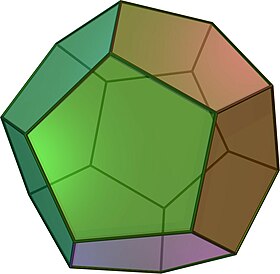 (Click here for rotating model) |
|
| Type | Platonic solid |
| Elements | F = 12, E = 30 V = 20 (χ = 2) |
| Faces by sides | 12{5} |
| Conway notation | D |
| Schläfli symbols | {5,3} |
| Face configuration | V3.3.3.3.3 |
| Wythoff symbol | 3 | 2 5 |
| Coxeter diagram | |
| Symmetry | Ih, H3, [5,3], (*532) |
| Rotation group | I, [5,3]+, (532) |
| References | U23, C26, W5 |
| Properties | regular, convex |
| Dihedral angle | 116.56505° = arccos(−1⁄√5) |
 5.5.5 (Vertex figure) |
 Regular icosahedron (dual polyhedron) |
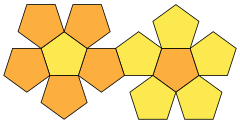 Net |

Animation of a net of a regular (pentagonal) dodecahedron being folded

3D model of a regular dodecahedron

Crystal structure of Co20L12 dodecahedron reported by Kai Wu, Jonathan Nitschke and co-workers at University of Cambridge in Nat. Synth. 2023, DOI:10.1038/s44160-023-00276-9 [1]
A regular dodecahedron or pentagonal dodecahedron is a dodecahedron that is regular, which is composed of 12 regular pentagonal faces, three meeting at each vertex. It is one of the five Platonic solids. It has 12 faces, 20 vertices, 30 edges, and 160 diagonals (60 face diagonals, 100 space diagonals).[2] It is represented by the Schläfli symbol {5,3}.
Dimensions[edit]
If the edge length of a regular dodecahedron is 
(sequence A179296 in the OEIS)
and the radius of an inscribed sphere (tangent to each of the regular dodecahedron’s faces) is
while the midradius, which touches the middle of each edge, is
These quantities may also be expressed as
where ϕ is the golden ratio.
Note that, given a regular dodecahedron of edge length one, ru is the radius of a circumscribing sphere about a cube of edge length ϕ, and ri is the apothem of a regular pentagon of edge length ϕ.
Surface area and volume[edit]
The surface area A and the volume V of a regular dodecahedron of edge length a are:
Additionally, the surface area and volume of a regular dodecahedron are related to the golden ratio. A dodecahedron with an edge length of one unit has the properties:[3]
Two-dimensional symmetry projections[edit]
The regular dodecahedron has two high orthogonal projections, centered, on vertices and pentagonal faces, correspond to the A2 and H2 Coxeter planes. The edge-center projection has two orthogonal lines of reflection.
| Centered by | Vertex | Face | Edge |
|---|---|---|---|
| Image | 
|

|
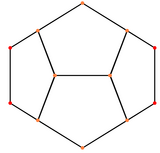
|
| Projective symmetry |
[[3]] = [6] | [[5]] = [10] | [2] |
In perspective projection, viewed on top of a pentagonal face, the regular dodecahedron can be seen as a linear-edged Schlegel diagram, or stereographic projection as a spherical polyhedron. These projections are also used in showing the four-dimensional 120-cell, a regular 4-dimensional polytope, constructed from 120 dodecahedra, projecting it down to 3-dimensions.
| Projection | Orthogonal projection | Perspective projection | |
|---|---|---|---|
| Schlegel diagram | Stereographic projection | ||
| Regular dodecahedron | 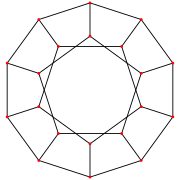
|

|

|
| Dodecaplex (120-cell) |

|
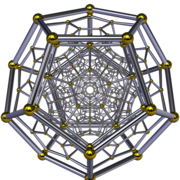
|

|
Spherical tiling[edit]
The regular dodecahedron can also be represented as a spherical tiling.

|

|
| Orthographic projection | Stereographic projection |
|---|
Cartesian coordinates[edit]
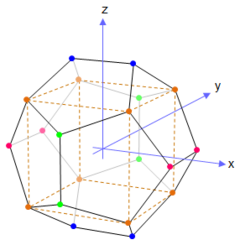
| Vertex coordinates: | |
| The orange vertices lie at (±1, ±1, ±1) and form a cube (dotted lines). | |
| The green vertices lie at (0, ±ϕ, ±1/ϕ) and form a rectangle on the yz-plane. | |
| The blue vertices lie at (±1/ϕ, 0, ±ϕ) and form a rectangle on the xz-plane. | |
| The pink vertices lie at (±ϕ, ±1/ϕ, 0) and form a rectangle on the xy-plane. | |
| The distance between adjacent vertices is 2/ϕ, and the distance from the origin to any vertex is √3. ϕ = 1 + √5/2 is the golden ratio. |
The following Cartesian coordinates define the 20 vertices of a regular dodecahedron centered at the origin and suitably scaled and oriented:[4]
- (±1, ±1, ±1)
- (0, ±ϕ, ±1/ϕ)
- (±1/ϕ, 0, ±ϕ)
- (±ϕ, ±1/ϕ, 0)
where ϕ = 1 + √5/2 is the golden ratio (also written τ) ≈ 1.618. The edge length is 2/ϕ = √5 − 1. The circumradius is √3.
Facet-defining equations[edit]
Similar to the symmetry of the vertex coordinates, the equations of the twelve facets of the regular dodecahedron also display symmetry in their coefficients:
- x ± ϕy = ±ϕ2
- y ± ϕz = ±ϕ2
- z ± ϕx = ±ϕ2
Properties[edit]
- The dihedral angle of a regular dodecahedron is 2 arctan(ϕ) or approximately 116.565° (where again ϕ = 1 + √5/2, the golden ratio). OEIS: A137218 Note that the tangent of the dihedral angle is exactly −2.
- If the original regular dodecahedron has edge length 1, its dual icosahedron has edge length ϕ.
- If the five Platonic solids are built with same volume, the regular dodecahedron has the shortest edges.
- It has 43,380 nets.
- The map-coloring number of a regular dodecahedron’s faces is 4.
- The distance between the vertices on the same face not connected by an edge is ϕ times the edge length.
- If two edges share a common vertex, then the midpoints of those edges form a 36-72-72 golden triangle with the body center.
As a configuration[edit]
This configuration matrix represents the dodecahedron. The rows and columns correspond to vertices, edges, and faces. The diagonal numbers say how many of each element occur in the whole dodecahedron. The nondiagonal numbers say how many of the column’s element occur in or at the row’s element.[5][6]

Here is the configuration expanded with k-face elements and k-figures. The diagonal element counts are the ratio of the full Coxeter group H3, order 120, divided by the order of the subgroup with mirror removal.
| H3 | k-face | fk | f0 | f1 | f2 | k-fig | Notes | |
|---|---|---|---|---|---|---|---|---|
| A2 | ( ) | f0 | 20 | 3 | 3 | {3} | H3/A2 = 120/6 = 20 | |
| A1A1 | { } | f1 | 2 | 30 | 2 | { } | H3/A1A1 = 120/4 = 30 | |
| H2 | {5} | f2 | 5 | 5 | 12 | ( ) | H3/H2 = 120/10 = 12 |
Geometric relations[edit]
The regular dodecahedron is the third in an infinite set of truncated trapezohedra which can be constructed by truncating the two axial vertices of a pentagonal trapezohedron.
The stellations of the regular dodecahedron make up three of the four Kepler–Poinsot polyhedra.
A rectified regular dodecahedron forms an icosidodecahedron.
The regular dodecahedron has icosahedral symmetry Ih, Coxeter group [5,3], order 120, with an abstract group structure of A5 × Z2.
Relation to the regular icosahedron[edit]
The dodecahedron and icosahedron are dual polyhedra. A regular dodecahedron has 12 faces and 20 vertices, whereas a regular icosahedron has 20 faces and 12 vertices. Both have 30 edges.
When a regular dodecahedron is inscribed in a sphere, it occupies more of the sphere’s volume (66.49%) than an icosahedron inscribed in the same sphere (60.55%).
A regular dodecahedron with edge length 1 has more than three and a half times the volume of an icosahedron with the same length edges (7.663… compared with 2.181…), which ratio is approximately 3.51246117975, or in exact terms: 3/5(3ϕ + 1) or (1.8ϕ + 0.6).
Relation to the nested cube[edit]
A cube can be embedded within a regular dodecahedron, affixed to eight of its equidistant vertices, in five different positions.[7] In fact, five cubes may overlap and interlock inside the regular dodecahedron to result in the compound of five cubes.
The ratio of the edge of a regular dodecahedron to the edge of a cube embedded inside such a regular dodecahedron is 1 : ϕ, or (ϕ − 1) : 1.
The ratio of a regular dodecahedron’s volume to the volume of a cube embedded inside such a regular dodecahedron is 1 : 2/2 + ϕ, or 1 + ϕ/2 : 1, or (5 + √5) : 4.
For example, an embedded cube with a volume of 64 (and edge length of 4), will nest within a regular dodecahedron of volume 64 + 32ϕ (and edge length of 4ϕ − 4).
Thus, the difference in volume between the encompassing regular dodecahedron and the enclosed cube is always one half the volume of the cube times ϕ.
From these ratios are derived simple formulas for the volume of a regular dodecahedron with edge length a in terms of the golden mean:
- V = (aϕ)3 · 1/4(5 + √5)
- V = 1/4(14ϕ + 8)a3
Relation to the regular tetrahedron[edit]
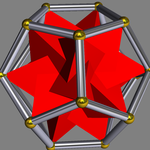
Five tetrahedra inscribed in a dodecahedron. Five opposing tetrahedra (not shown) can also be inscribed.
As two opposing tetrahedra can be inscribed in a cube, and five cubes can be inscribed in a dodecahedron, ten tetrahedra in five cubes can be inscribed in a dodecahedron: two opposing sets of five, with each set covering all 20 vertices and each vertex in two tetrahedra (one from each set, but not the opposing pair).
Just as a tetrahedron can be inscribed in a cube, so a cube can be inscribed in a dodecahedron. By reciprocation, this leads to an octahedron circumscribed about an icosahedron. In fact, each of the twelve vertices of the icosahedron divides an edge of the octahedron according to the “golden section”. Given the icosahedron, the circumscribed octahedron can be chosen in five ways, giving a compound of five octahedra, which comes under our definition of stellated icosahedron. (The reciprocal compound, of five cubes whose vertices belong to a dodecahedron, is a stellated triacontahedron.) Another stellated icosahedron can at once be deduced, by stellating each octahedron into a stella octangula, thus forming a compound of ten tetrahedra. Further, we can choose one tetrahedron from each stella octangula, so as to derive a compound of five tetrahedra, which still has all the rotation symmetry of the icosahedron (i.e. the icosahedral group), although it has lost the reflections. By reflecting this figure in any plane of symmetry of the icosahedron, we obtain the complementary set of five tetrahedra. These two sets of five tetrahedra are enantiomorphous, i.e. not directly congruent, but related like a pair of shoes. [Such] a figure which possesses no plane of symmetry (so that it is enantiomorphous to its mirror-image) is said to be chiral.[8]
Relation to the golden rectangle[edit]
Golden rectangles of ratio (ϕ + 1) : 1 and ϕ : 1 also fit perfectly within a regular dodecahedron.[9] In proportion to this golden rectangle, an enclosed cube’s edge is ϕ, when the long length of the rectangle is ϕ + 1 (or ϕ2) and the short length is 1 (the edge shared with the regular dodecahedron).
In addition, the center of each face of the regular dodecahedron form three intersecting golden rectangles.[10]
Relation to the 6-cube and rhombic triacontahedron[edit]

Projection of 6-demicube into regular dodecahedral envelope
It can be projected to 3D from the 6-dimensional 6-demicube using the same basis vectors that form the hull of the rhombic triacontahedron from the 6-cube. Shown here including the inner 12 vertices, which are not connected by the outer hull edges of 6D norm length √2, form a regular icosahedron.
The 3D projection basis vectors [u,v,w] used are:
- u = (1, ϕ, 0, −1, ϕ, 0)
- v = (ϕ, 0, 1, ϕ, 0, −1)
- w = (0, 1, ϕ, 0, −1, ϕ)
History and uses[edit]


Omnidirectional sound source
Regular dodecahedral objects have found some practical applications, and have also played a role in the visual arts and in philosophy.
Iamblichus states that Hippasus, a Pythagorean, perished in the sea, because he boasted that he first divulged “the sphere with the twelve pentagons.”[11] In Theaetetus, a dialogue of Plato, Plato hypothesized that the classical elements were made of the five uniform regular solids; these later became known as the platonic solids. Of the fifth Platonic solid, the dodecahedron, Plato obscurely remarked, “…the god used [it] for arranging the constellations on the whole heaven”. Timaeus (c. 360 BC), as a personage of Plato’s dialogue, associates the other four platonic solids with the four classical elements, adding that there is a fifth solid pattern which, though commonly associated with the regular dodecahedron, is never directly mentioned as such; “this God used in the delineation of the universe.”[12] Aristotle also postulated that the heavens were made of a fifth element, which he called aithêr (aether in Latin, ether in American English).
Theaetetus gave a mathematical description of all five and may have been responsible for the first known proof that no other convex regular polyhedra exist.
Euclid completely mathematically described the Platonic solids in the Elements, the last book (Book XIII) of which is devoted to their properties. Propositions 13–17 in Book XIII describe the construction of the tetrahedron, octahedron, cube, icosahedron, and dodecahedron in that order. For each solid Euclid finds the ratio of the diameter of the circumscribed sphere to the edge length. In Proposition 18 he argues that there are no further convex regular polyhedra.
Regular dodecahedra have been used as dice and probably also as divinatory devices. During the Hellenistic era, small, hollow bronze Roman dodecahedra were made and have been found in various Roman ruins in Europe. Their purpose is not certain.
In 20th-century art, dodecahedra appear in the work of M. C. Escher, such as his lithographs Reptiles (1943) and Gravitation (1952). In Salvador Dalí’s painting The Sacrament of the Last Supper (1955), the room is a hollow regular dodecahedron. Gerard Caris based his entire artistic oeuvre on the regular dodecahedron and the pentagon, which is presented as a new art movement coined as Pentagonism.

A climbing wall consisting of three dodecahedral pieces
In modern role-playing games, the regular dodecahedron is often used as a twelve-sided die, one of the more common polyhedral dice.
Immersive Media Company, a former Canadian digital imaging company, made the Dodeca 2360 camera, the world’s first 360° full-motion camera which captures high-resolution video from every direction simultaneously at more than 100 million pixels per second or 30 frames per second.[promotion?] It is based on regular dodecahedron.[citation needed]
The Megaminx twisty puzzle, alongside its larger and smaller order analogues, is in the shape of a regular dodecahedron.
In the children’s novel The Phantom Tollbooth, the regular dodecahedron appears as a character in the land of Mathematics. Each of his faces wears a different expression – e.g. happy, angry, sad – which he swivels to the front as required to match his mood.
In nature and supramolecules[edit]

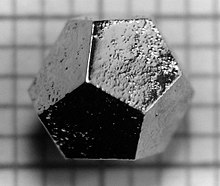
The fossil coccolithophore Braarudosphaera bigelowii (see figure), a unicellular coastal phytoplanktonic alga, has a calcium carbonate shell with a regular dodecahedral structure about 10 micrometers across.[13]
Some quasicrystals and cages have dodecahedral shape (see figure). Some regular crystals such as garnet and diamond are also said to exhibit “dodecahedral” habit, but this statement actually refers to the rhombic dodecahedron shape.[14] [1]
Shape of the universe[edit]
Various models have been proposed for the global geometry of the universe. In addition to the primitive geometries, these proposals include the Poincaré dodecahedral space, a positively curved space consisting of a regular dodecahedron whose opposite faces correspond (with a small twist). This was proposed by Jean-Pierre Luminet and colleagues in 2003,[15][16] and an optimal orientation on the sky for the model was estimated in 2008.[17]
In Bertrand Russell’s 1954 short story “The Mathematician’s Nightmare: The Vision of Professor Squarepunt,” the number 5 said: “I am the number of fingers on a hand. I make pentagons and pentagrams. And but for me dodecahedra could not exist; and, as everyone knows, the universe is a dodecahedron. So, but for me, there could be no universe.”
Space filling with cube and bilunabirotunda[edit]
Regular dodecahedra fill space with cubes and bilunabirotundas (Johnson solid 91), in the ratio of 1 to 1 to 3.[18][19] The dodecahedra alone make a lattice of edge-to-edge pyritohedra. The bilunabirotundas fill the rhombic gaps. Each cube meets six bilunabirotundas in three orientations.
Related polyhedra and tilings[edit]
The regular dodecahedron is topologically related to a series of tilings by vertex figure n3.
*n32 symmetry mutation of regular tilings: {n,3}
|
|||||||||||
|---|---|---|---|---|---|---|---|---|---|---|---|
| Spherical | Euclidean | Compact hyperb. | Paraco. | Noncompact hyperbolic | |||||||

|

|

|

|

|

|

|

|

|

|

|

|
| {2,3} | {3,3} | {4,3} | {5,3} | {6,3} | {7,3} | {8,3} | {∞,3} | {12i,3} | {9i,3} | {6i,3} | {3i,3} |
The regular dodecahedron can be transformed by a truncation sequence into its dual, the icosahedron:
| Family of uniform icosahedral polyhedra | |||||||
|---|---|---|---|---|---|---|---|
| Symmetry: [5,3], (*532) | [5,3]+, (532) | ||||||

|

|

|

|

|

|

|

|
| {5,3} | t{5,3} | r{5,3} | t{3,5} | {3,5} | rr{5,3} | tr{5,3} | sr{5,3} |
| Duals to uniform polyhedra | |||||||

|

|

|

|

|
|||
| V5.5.5 | V3.10.10 | V3.5.3.5 | V5.6.6 | V3.3.3.3.3 | V3.4.5.4 | V4.6.10 | V3.3.3.3.5 |
| Uniform octahedral polyhedra | ||||||||||
|---|---|---|---|---|---|---|---|---|---|---|
| Symmetry: [4,3], (*432) | [4,3]+ (432) |
[1+,4,3] = [3,3] (*332) |
[3+,4] (3*2) |
|||||||
| {4,3} | t{4,3} | r{4,3} r{31,1} |
t{3,4} t{31,1} |
{3,4} {31,1} |
rr{4,3} s2{3,4} |
tr{4,3} | sr{4,3} | h{4,3} {3,3} |
h2{4,3} t{3,3} |
s{3,4} s{31,1} |
= |
= |
= |
||||||||
| Duals to uniform polyhedra | ||||||||||
| V43 | V3.82 | V(3.4)2 | V4.62 | V34 | V3.43 | V4.6.8 | V34.4 | V33 | V3.62 | V35 |
The regular dodecahedron is a member of a sequence of otherwise non-uniform polyhedra and tilings, composed of pentagons with face configurations (V3.3.3.3.n). (For n > 6, the sequence consists of tilings of the hyperbolic plane.) These face-transitive figures have (n32) rotational symmetry.
n32 symmetry mutations of snub tilings: 3.3.3.3.n
|
||||||||
|---|---|---|---|---|---|---|---|---|
| Symmetry n32 |
Spherical | Euclidean | Compact hyperbolic | Paracomp. | ||||
| 232 | 332 | 432 | 532 | 632 | 732 | 832 | ∞32 | |
| Snub figures |

|

|

|

|

|

|

|

|
| Config. | 3.3.3.3.2 | 3.3.3.3.3 | 3.3.3.3.4 | 3.3.3.3.5 | 3.3.3.3.6 | 3.3.3.3.7 | 3.3.3.3.8 | 3.3.3.3.∞ |
| Gyro figures |

|

|

|

|

|

|

|

|
| Config. | V3.3.3.3.2 | V3.3.3.3.3 | V3.3.3.3.4 | V3.3.3.3.5 | V3.3.3.3.6 | V3.3.3.3.7 | V3.3.3.3.8 | V3.3.3.3.∞ |
Vertex arrangement[edit]
The regular dodecahedron shares its vertex arrangement with four nonconvex uniform polyhedra and three uniform polyhedron compounds.
Five cubes fit within, with their edges as diagonals of the regular dodecahedron’s faces, and together these make up the regular polyhedral compound of five cubes. Since two tetrahedra can fit on alternate cube vertices, five and ten tetrahedra can also fit in a regular dodecahedron.
Stellations[edit]
The 3 stellations of the regular dodecahedron are all regular (nonconvex) polyhedra: (Kepler–Poinsot polyhedra)
| 0 | 1 | 2 | 3 | |
|---|---|---|---|---|
| Stellation | 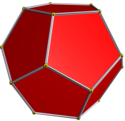 Regular dodecahedron |
 Small stellated dodecahedron |
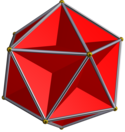 Great dodecahedron |
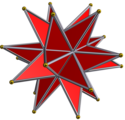 Great stellated dodecahedron |
| Facet diagram | 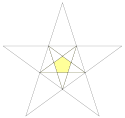
|

|

|
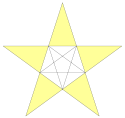
|
Dodecahedral graph[edit]
| Regular dodecahedron graph | |
|---|---|
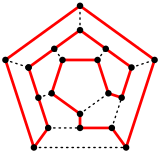
A Hamiltonian cycle in a dodecahedron. |
|
| Vertices | 20 |
| Edges | 30 |
| Radius | 5 |
| Diameter | 5 |
| Girth | 5 |
| Automorphisms | 120 (A5 × Z2)[20] |
| Chromatic number | 3 |
| Properties | Hamiltonian, regular, symmetric, distance-regular, distance-transitive, 3-vertex-connected, planar graph |
| Table of graphs and parameters |
The skeleton of the dodecahedron (the vertices and edges) form a graph. It is one of 5 Platonic graphs, each a skeleton of its Platonic solid.
This graph can also be constructed as the generalized Petersen graph G(10,2). The high degree of symmetry of the polygon is replicated in the properties of this graph, which is distance-transitive, distance-regular, and symmetric. The automorphism group has order 120. The vertices can be colored with 3 colors, as can the edges, and the diameter is 5.[21]
The dodecahedral graph is Hamiltonian – there is a cycle containing all the vertices. Indeed, this name derives from a mathematical game invented in 1857 by William Rowan Hamilton, the icosian game. The game’s object was to find a Hamiltonian cycle along the edges of a dodecahedron.

|
See also[edit]
- 120-cell, a regular polychoron (4D polytope whose surface consists of 120 dodecahedral cells)
- Braarudosphaera bigelowii − A dodecahedron shaped coccolithophore (a unicellular phytoplankton algae).
- Dodecahedrane (molecule)
- Pentakis dodecahedron
- Snub dodecahedron
- Truncated dodecahedron
References[edit]
- ^ a b Kai Wu, Jonathan Nitschke and co-workers “Systematic construction of progressively larger capsules from a fivefold linking pyrrole-based subcomponent”, Nature Synthesis, 2023, DOI: https://doi.org/10.1038/s44160-023-00276-9.
- ^ Sutton, Daud (2002), Platonic & Archimedean Solids, Wooden Books, Bloomsbury Publishing USA, p. 55, ISBN 9780802713865.
- ^ Livio, Mario (2003) [2002]. The Golden Ratio: The Story of Phi, the World’s Most Astonishing Number (First trade paperback ed.). New York City: Broadway Books. pp. 70–1. ISBN 0-7679-0816-3.
- ^ Weisstein, Eric W. “Icosahedral group”. MathWorld.
- ^ Coxeter, H.S.M. (1973) [1948]. “§1.8 Configurations”. Regular Polytopes (3rd ed.). New York: Dover.
- ^ Coxeter, H.S.M. (1991). Regular Complex Polytopes (2nd ed.). Cambridge: Cambridge University Press. p. 117.
- ^ http://mathworld.wolfram.com/images/eps-gif/DodecahedronCube_700.gif[bare URL image file]
- ^ Coxeter, H.S.M.; du Val, Patrick; Flather, H.T.; Petrie, J.F. (1938). The Fifty-Nine Icosahedra. Vol. 6. University of Toronto Studies (Mathematical Series). p. 4.
- ^ Knott, Ron (26 September 2016). “The Golden Geometry of Solids or Phi in 3 dimensions”. Ron Knott’s Mathematics Pages. Retrieved 2022-03-19.
- ^ http://www.toshen.com/images/dodecahedronwithgoldrectang.gif[bare URL image file]
- ^ Florian Cajori, A History of Mathematics (1893)
- ^ Plato, Timaeus, Jowett translation [line 1317–8]; the Greek word translated as delineation is diazographein, painting in semblance of life.
- ^ Hagino, K., Onuma, R., Kawachi, M. and Horiguchi, T. (2013) “Discovery of an endosymbiotic nitrogen-fixing cyanobacterium UCYN-A in Braarudosphaera bigelowii (Prymnesiophyceae)”. PLoS One, 8(12): e81749. doi:10.1371/journal.pone.0081749.
- ^ Dodecahedral Crystal Habit Archived 12 April 2009 at the Wayback Machine
- ^ Dumé, Belle (Oct 8, 2003). “Is The Universe A Dodecahedron?”. PhysicsWorld. Archived from the original on 2012-04-25.
- ^ Luminet, Jean-Pierre; Jeff Weeks; Alain Riazuelo; Roland Lehoucq; Jean-Phillipe Uzan (2003-10-09). “Dodecahedral space topology as an explanation for weak wide-angle temperature correlations in the cosmic microwave background”. Nature. 425 (6958): 593–5. arXiv:astro-ph/0310253. Bibcode:2003Natur.425..593L. doi:10.1038/nature01944. PMID 14534579. S2CID 4380713.
- ^ Roukema, Boudewijn; Zbigniew Buliński; Agnieszka Szaniewska; Nicolas E. Gaudin (2008). “A test of the Poincaré dodecahedral space topology hypothesis with the WMAP CMB data”. Astronomy and Astrophysics. 482 (3): 747. arXiv:0801.0006. Bibcode:2008A&A…482..747L. doi:10.1051/0004-6361:20078777. S2CID 1616362.
- ^ “Dodecahedron and Bilunabirotunda – Wolfram Demonstrations Project”.
- ^ http://www.lcv.ne.jp/~hhase/memo/m09_08b.html
- ^ Frucht, Roberto (1936–1937), “Die gruppe des Petersen’schen Graphen und der Kantensysteme der regulären Polyeder”, Comment. Math. Helv., 9: 217–223, doi:10.1007/bf01258190, S2CID 121791222
- ^ Weisstein, Eric W. “Dodecahedral Graph”. MathWorld.
External links[edit]
- Weisstein, Eric W. “Regular Dodecahedron”. MathWorld.
- Klitzing, Richard. “3D convex uniform polyhedra o3o5x – doe”.
- Editable printable net of a dodecahedron with interactive 3D view
- The Uniform Polyhedra
- Origami Polyhedra – Models made with Modular Origami
- Dodecahedron – 3-d model that works in your browser
- Virtual Reality Polyhedra The Encyclopedia of Polyhedra
- VRML#Regular dodecahedron
- K.J.M. MacLean, A Geometric Analysis of the Five Platonic Solids and Other Semi-Regular Polyhedra
- Dodecahedron 3D Visualization
- Stella: Polyhedron Navigator: Software used to create some of the images on this page.
- How to make a dodecahedron from a Styrofoam cube
- The Greek, Indian, and Chinese Elements – Seven Element Theory
Fundamental convex regular and uniform polytopes in dimensions 2–10 |
|||||
|---|---|---|---|---|---|
| Family | An | Bn | I2(p) / Dn | E6 / E7 / E8 / F4 / G2 | Hn |
| Regular polygon | Triangle | Square | p-gon | Hexagon | Pentagon |
| Uniform polyhedron | Tetrahedron | Octahedron • Cube | Demicube | Dodecahedron • Icosahedron | |
| Uniform polychoron | Pentachoron | 16-cell • Tesseract | Demitesseract | 24-cell | 120-cell • 600-cell |
| Uniform 5-polytope | 5-simplex | 5-orthoplex • 5-cube | 5-demicube | ||
| Uniform 6-polytope | 6-simplex | 6-orthoplex • 6-cube | 6-demicube | 122 • 221 | |
| Uniform 7-polytope | 7-simplex | 7-orthoplex • 7-cube | 7-demicube | 132 • 231 • 321 | |
| Uniform 8-polytope | 8-simplex | 8-orthoplex • 8-cube | 8-demicube | 142 • 241 • 421 | |
| Uniform 9-polytope | 9-simplex | 9-orthoplex • 9-cube | 9-demicube | ||
| Uniform 10-polytope | 10-simplex | 10-orthoplex • 10-cube | 10-demicube | ||
| Uniform n-polytope | n-simplex | n-orthoplex • n-cube | n-demicube | 1k2 • 2k1 • k21 | n-pentagonal polytope |
| Topics: Polytope families • Regular polytope • List of regular polytopes and compounds |
Формулы:
A = 3 * a² * √ 25 + 10 * √5
V = a³ / 4 * ( 15 + 7 * √5 )
re = a / 4 * √3 * ( 1 + √5 )
rm = a / 4 * ( 3 + √5 )
ri = a / 2 * √ ( 25 + 11 * √5 ) / 10
Длина ребра и радиусы имеют одинаковые единицы (например, метры), площадь – те же единицы, возведенные в квадрат (например, квадратный метр), объем – единицы, возведенные в куб (например, кубический метр).
![]()
Общая площадь поверхности додекаэдра Калькулятор
| Search | ||
| Дом | математика ↺ | |
| математика | Геометрия ↺ | |
| Геометрия | 3D геометрия ↺ | |
| 3D геометрия | Платоновы тела ↺ | |
| Платоновы тела | Додекаэдр ↺ | |
| Додекаэдр | Площадь поверхности додекаэдра ↺ | |
| Площадь поверхности додекаэдра | Общая площадь поверхности додекаэдра ↺ |
|
✖Длина ребра додекаэдра — это длина любого из ребер додекаэдра или расстояние между любой парой смежных вершин додекаэдра.ⓘ Длина ребра додекаэдра [le] |
+10% -10% |
|
✖Общая площадь поверхности додекаэдра – это общее количество плоскостей, заключенных во всей поверхности додекаэдра.ⓘ Общая площадь поверхности додекаэдра [TSA] |
⎘ копия |
Общая площадь поверхности додекаэдра Решение
ШАГ 0: Сводка предварительного расчета
ШАГ 1. Преобразование входов в базовый блок
Длина ребра додекаэдра: 10 метр –> 10 метр Конверсия не требуется
ШАГ 2: Оцените формулу
ШАГ 3: Преобразуйте результат в единицу вывода
2064.57288070676 Квадратный метр –> Конверсия не требуется
12 Общая площадь поверхности додекаэдра Калькуляторы
8 Площадь додекаэдра Калькуляторы
Общая площадь поверхности додекаэдра формула
Общая площадь поверхности додекаэдра = 3*sqrt(25+(10*sqrt(5)))*Длина ребра додекаэдра^2
TSA = 3*sqrt(25+(10*sqrt(5)))*le^2
Что такое додекаэдр?
Додекаэдр представляет собой симметричную и замкнутую трехмерную форму с 12 одинаковыми пятиугольными гранями. Это платоново тело, имеющее 12 граней, 20 вершин и 30 ребер. В каждой вершине встречаются три пятиугольные грани, а в каждом ребре встречаются две пятиугольные грани. Из всех пяти платоновых тел с одинаковой длиной ребра додекаэдр будет иметь наибольшее значение объема и площади поверхности.
Что такое Платоновые тела?
В трехмерном пространстве Платоново тело представляет собой правильный выпуклый многогранник. Он строится из конгруэнтных (одинаковых по форме и размеру), правильных (все углы равны и все стороны равны) многоугольных граней с одинаковым числом граней, сходящихся в каждой вершине. Пять тел, отвечающих этому критерию, — это тетраэдр {3,3}, куб {4,3}, октаэдр {3,4}, додекаэдр {5,3}, икосаэдр {3,5}; где в {p, q} p представляет количество ребер на грани, а q представляет количество ребер, встречающихся в вершине; {p, q} — символ Шлефли.
















